Introduction: This is among Sam Rohdie’s earliest published writings on film. It appeared in the 1969 book Samuel Fuller edited by David Will and Peter Wollen for the Edinburgh Film Festival retrospective of that year, as Sam was hitting 30 (he also contributed to New Left Review in this period). As he recounts in his 2009 career-interview with Deane Williams, Sam, at this point in his life, had moved from Ghana (where he first developed a strong interest in cinema, crossed with structural anthropology) to Britain, teaching at Sheffield Art College and eventually taking up a position as General Secretary of the Society for Education in Film and Television – which included the editorship of Screen journal. The Fuller book occurred at the head of a line of significant Edinburgh publications which would go on to include Roger Corman, Douglas Sirk, Raoul Walsh, Jacques Tourneur, and eventually the thematic publications on psychoanalysis, and history. At the dawn of this turbulent and transformative period in UK film culture, Will and Wollen’s editorial approach to the Fuller project was democratic and diverse, not yet as sectarian or polemical as their successors in the same role, including Claire Johnston and Paul Willemen. Here, in 1969, V.F. Perkins from Movie, Thomas Elsaesser of the Brighton Film Review (soon to become Monogram), Raymond Durgnat and many others share equal airtime. Sam’s contribution is strikingly of a piece with much of his later work, all the way through to the 2014 study of Julien Duvivier published in this issue of Screening the Past: broad structures/forms plus select, striking moments from Fuller’s 1955 film are vividly evoked and celebrated, their translation into prose reiterated and varied in a relentless, lyrical parataxis. As well, a proto-deconstructive, dynamically paradoxical logic (some time before Sam began reading, quoting and using Jacques Derrida) is uncovered: in the apparent realism of House of Bamboo there is abstraction; reality-as-appearance and movie-as-appearance constantly (‘dialectically’) swap places; and “Fuller is often most poetic aesthetically when the content of his composition is most repulsive”. In this text (which already signals his frequently intense anti-Americanism) we can gauge Sam’s inexorable move away from the systematic (sometimes rigid) protocols of cine-structuralism, and toward the fluidity and playfulness of poststructuralism. [Adrian Martin, June 2015]
Fuller has, one suspects, little sympathy for anyone who lives vicariously in the cinema.
– Victor Perkins
… it seems to me that Fuller is the film director whose methodology closest approaches Brecht’s theatre.
– Lee Russell [aka Peter Wollen]
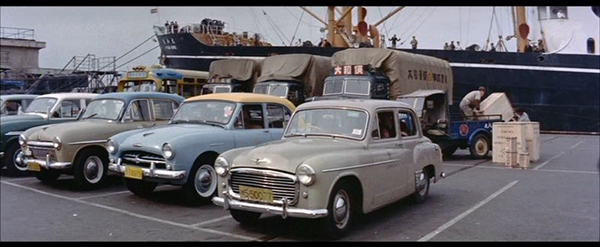
Behind the Screen
The gear of Japanese workers hides a gang of ex-Army, ex-con American thugs. Behind their translucent house of bamboo walls are a barracks and military operations room. In back of Tokyo pachinko parlour screens sit Sandy (Robert Ryan) and the gang, running an organised protection racket.
Fuller forever plays on, and sometimes reveals, the reality behind appearance. Eddie Spanier (Robert Stack) is Sergeant Kenner. The ‘kimono girl’ Mariko (Shirley Yamaguchi) is the respectable woman, is the spy-informer Mariko. The journalist is the double-agent. Captain Hanson (Brad Dexter) is the civilian whoring it in hotel bedrooms. The outline of Spanier behind the bamboo-screened pearl office is the outline of one of the thugs. Spanier and Mariko love-making is a fake to fool the gang.
Characters are as mystified, deceived about reality as the audience viewing appearances. It does seem that Spanier is Spanier. It does appear that Sandy will slug Mariko for playing informer, but slugs her instead for an infidelity toward Spanier. The apparent infidelity was a betrayal of the gang to the army.
Sandy believes Mariko’s lies as truths, her truths as lies. He mistakes loyalty for treachery and murders Griff (Cameron Mitchell), treachery for loyalty and saves Spanier. Mariko takes a faked photograph of Spanier and her dead husband Webber (Biff Elliot) as honest – “You are Eddie Spanier”. She does not question his aim of personal revenge while, in fact, he represents the revenge of the army, the double-agent after the murderer of the army’s own.
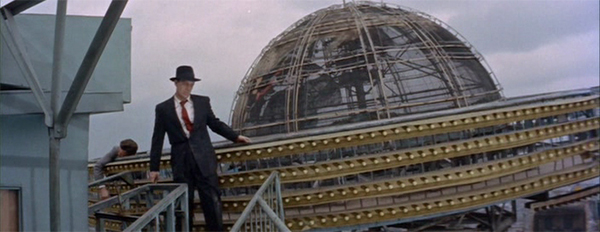
Identity/Loyalty
The protagonist Kenner/Spanier and the lesser figures are all involved in a complex dialectic of loyalty and treachery consequent on their roles as double-agents. They have ambiguous identities, engage in ambiguous action. The confusions of the movie for an audience rest on this kind of ambiguity, the difficulty of resolving with certainty that an action is this or that, an identity what it appears to be. Despite Fuller’s apparent realism, the utter concreteness of image, all his movies have a semi-abstract quality due to the impossibility of ever fully identifying what appears on the screen. People and happenings are usually other than what they seem but, even when this other is revealed (that Spanier is Kenner), further confusions are introduced.
To identify in Fuller’s movies is to know. The difficulty of identification complicates allegiance, confuses loyalties. This problem goes beyond the action within the movie toward a relation between Fuller and his audience.
Kenner/Spanier is the protagonist, but no hero. His actions are a compound of betrayal, loyalty, deceit, honesty, violence, sentimentality, criminality, justice. He cannot be clearly identified, or identified with, precisely because of the complexity – rather, the contradictions – of his person. He is neither one thing nor another.
Fuller’s themes, and the characters who sometimes embody these, prevent the emotional identification, the involvement characteristic of most movies. An audience must think about what goes on, decide upon identity, hence its own loyalties, but is disallowed from any kind of unthinking acceptance, of losing itself in the movie fantasy. Whatever assumptions an audience is first made to take, Fuller soon upsets and explodes. Whatever characters it seeks to become one with become too ambiguous and contradictory to remain with.
Kenner/Spanier, double-agent, seeks the identity of the killer of the American army train guard. One’s own task is similar, though not the same. Kenner/Spanier must become a liar, a traitor, criminal on a revenge-seeking mission to defend America’s own.
The audience, assaulted in its assumptions, is itself placed in the position of double-agent. Like Spanier, it is between worlds: that of the screen, and its own. House of Bamboo is a confrontation with the American public, poses for it problems of allegiance and national identity. American values, built on a structure of revenge, are being protected in violent, underhand war by people dirtied in a filthy business, and often acting not for patriotism but for personal ends. Where does one stand? Many of Fuller’s films finish, “Will The End of This Story be Written by You?”
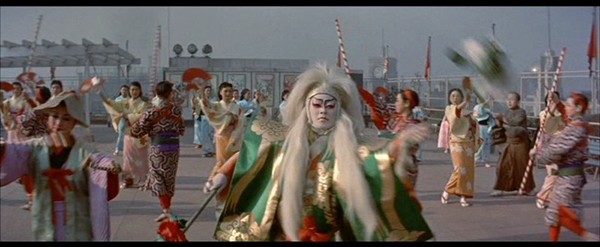
Past and Present
House of Bamboo begins as history, reported by a journalist-narrator. The movie is a true document, an account of immediate past events “in 1954, in Tokyo and the Japanese countryside”, not a re-created, spurious present, a trumped-up dream image. Fuller removes his audience from the action screened, by both affirming the reality of that action as actual past, and denying it any present reality in which one can forget, be lost, dream.
The contradiction – real historical past and the present tense of the screen – enforces Fuller’s thematic concerns with identity, the contradiction between appearance and reality.
Movies tend to make the screen co-extensive with the real world, absorbing the one into the other, by forcing audience identification with the screen fantasy, and involvement within it. Fuller makes this relation a dialectic switching between the outside world and the world of the screen. House of Bamboo is presented both as a movie and as reality. Fuller takes his audience constantly between the two, forcing them to decide about the action on the screen, using the screen to comment on their decisions. Fuller engages not the emotions but the intellect, demands a critical, rational, political consciousness.
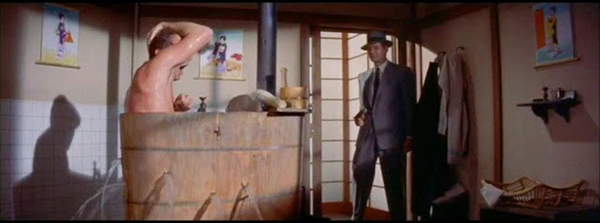
The Violence of Consciousness
Fuller’s movies are violent struggles against the medium, and against its audience. His thoughts about the world, about politics, are cinematic thoughts. To demand that one must choose despite contradictions between alternate images of the world implies a critical approach to cinema which is only appearance, faked, manipulated images whose only objective reality is the strip of celluloid.
Fuller wants one to think during the movie and to act after it, not to ingest, gobble it up as yet another culinary entertainment fare. But movies do tend toward the contrary of Fuller’s intentions and audiences, of course, collude with the tendency. To combat this requires a massive assault of which theme and the device of history are only parts.
Fuller’s movies have been noted as violent, perhaps the most violent of American cinema. But if true, it is not a matter of blood on the screen, gratuitous brutalities, gore or guts. Other directors surpass Fuller in this particular kind of sadism and overt bloodiness.
Fuller’s violence is a kind of intellectual shock rather than a visceral ‘shocking’ exhibition. When Spanier is slugged through a bamboo wall, Griff murdered in his bath, Mariko twice roughed up, Fuller is both revealing appearances, making clear what is going on, and reversing assumptions of the audience made on the basis of appearance, of what has been on the screen. The audience is shocked out of its own involvement – complacency, really – made aware of what is ‘actually’ happening on the screen, and is therefore made aware of what has happened to itself, its own mystifications. Fuller simultaneously jerks one out of the movie and back on oneself, and yet further into the movie by providing a new basis for knowledge, a new set of assumptions, a different yet (as he will show) only apparent reality.
This kind of violence, one punctuated by real violence (a punch), is reinforced by a violence of editing, colouring, and the staging of shots. Fuller’s violence of ‘style’ has the same ‘shock’, demystifying intellectual effect on the audience as his more obviously presented brutalities.
The pre-credit scene is set in the cold whiteness, bleached greys, ice browns of winter light. Soldiers and police stand frozen in set blue-brown triads, unblinking, unmoving, like statues of snow. The darting movement of a Japanese child in a bright, screaming red smock emphasises the dominant colours and icy tones. Such contrast is continual and persistent. Fuller sharply replaces one mood and atmosphere by its opposite, often within a single shot. Spanier passes with a punch from the warm red of the pachinko parlour, its glare and gaudy brightness, through a bamboo wall, to the static, almost pastel pink scene behind, where cold ice is thrown to revive him.
At the post cement-factory robbery celebration party, the dainty Japanese music, elegant movements, and pinks and browns of costumes and lighting, explode suddenly into rock-and-roll, jerky tossing, and a sudden garish presence of reds.
Spanier in search of Mariko, dressed in dirty-brown and brownish-blue, asks directions from seated brown-uniformed soldiers set against a grey background. A cut vaults him to a rooftop shimmering with an extreme colour tension between read and green, and the menacing dance of a Japanese troupe.
Fuller’s use of colour is no more arbitrary than his scenes of violence. Red announces danger; pinks and yellows in soft tones are the colour of love, of sentiment. But these ‘iconic’ existential bonds between colour and action, colour and movement, are part of a more comprehensive code, where meaning is conveyed by oppositions and contrasts, and where oppositions in themselves have a function in startling, in upsetting an audience mood, in preventing one from being lulled.
Fuller never conveys simple pleasures. The lasting images of his movies are at the same time very beautiful and very horrid. It is not possible to wallow in some pure aesthetic composition, to delight in the use of colour as such, an angle, or a line. Mt Fujiwara is strikingly composed by the foreshortened booted feet of a dead soldier. Fuller is often most poetic aesthetically when the content of his composition is most repulsive – the high-angle shot of Webber questioned in hospital, the frame of the cement-works before the attack, the fairground in the closing sequences.
On every level, Fuller remains ambiguous, contradictory. The final resolution of House of Bamboo remains with oneself.
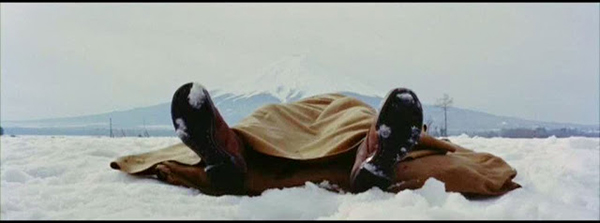
© Estate of Samuel Rohdie, 1969.
